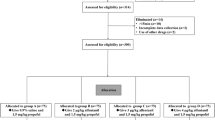Abstract
Background
Topical pharyngeal anesthesia as an adjunct to intravenous sedation to facilitate gastroscopy has been widely acknowledged; however, its efficacy has not been established when it is used in patients under deep sedation with propofol.
Aims
To demonstrate the limited value of topical pharyngeal anesthesia in patients under moderate to deep sedation with propofol.
Methods
One hundred and twenty-nine patients undergoing gastroscopy were prospectively randomized to receive 10 % lidocaine or distilled water topical spray as an adjunct to intravenous propofol via target-controlled infusion. Verbal and somatic responsiveness, presence of gag reflex and hiccup to esophageal intubation, and the overall ease of the procedure were evaluated by the anaesthetists and gastroenterologists. Hemodynamic parameters including peripheral oxygen saturation, systolic/diastolic blood pressure (SBP/DBP), heart rate (HR), bispectral index, and SBP × HR were compared at 5 time points: on arrival, after 5 spontaneous breaths, when estimated brain concentration of propofol, Ce, reached 3.5 μg/ml, on esophageal intubation, and on awakening.
Results
No statistical difference was observed between the lidocaine and distilled water group in verbal or somatic responses, gag reflex or hiccups on esophageal intubation. Similarly, BIS, SBP, DBP, and HR showed no significant difference between the groups.
Conclusions
The use of topical pharyngeal anesthesia in combination with target-controlled infusion with propofol in the performance of diagnostic gastroscopy might be eliminated without adversely affecting patient care or outcomes.


Similar content being viewed by others
References
Quine MA, Bell GD, McCloy RF, Charlton JE, Devlin HB, Hopkins A. Prospective audit of upper gastrointestinal endoscopy in two regions of England: safety, staffing, and sedation methods. Gut. 1995;36:462–467.
Zimmerman J, Rachmilewitz D. Systemic anaphylactic reaction following lidocaine administration. Gastrointest Endosc. 1985;31:404–405.
Abu-Laban RB, Zed PJ, Purssell RA, Evans KG. Severe methemoglobinemia from topical anesthetic spray: case report, discussion and qualitative systematic review. CJEM. 2001;3:51–56.
Brown CM, Levy SA, Susann PW. Methemoglobinemia: life threatening complication of endoscopy premedication. Am J Gastroenterol. 1994;89:1108–1109.
Dinneen SF, Mohr DN, Farbanks VF. Methemoglobinemia from topically applied anesthetic spray. Mayo Clin Proc. 1994;69:886–888.
Evans LT, Saberi S, Kim HM, Elta GH, Schoenfeld P. Pharyngeal anesthesia during sedated EGD: is “the spray” beneficial? A meta-analysis and systematic review. Gastrointest Endosc. 2006;63:761–766.
Gasparovic S, Rustemovic N, Opacic M, et al. Clinical analysis of propofol deep sedation for 1,104 patients undergoing gastrointestinal endoscopic procedure: a three year prospective study. World J Gastroenterol. 2006;12:327–330.
McQuaid K, Laine L. A systematic review and meta-analysis of randomized, controlled trials of moderate sedation for routine endoscopic procedures. Gastrointest Endosc. 2008;67:910–923.
American Society of Anaesthesiologists Task Force. Practice guidelines for sedation and analgesis by non-anaesthesiologists: an updated report by the American Society of Anaesthesiologists Task Force on Sedation and Analgesia by Non-Anaesthesiologists. Anesthesiology. 2002;96:1004–1017.
Schonemann NK, van der Burght M, Arendt-Nielsen L, Bjerring P. Onset and duration of hypoalgesia of lidocaine spray applied to oral mucosa—a dose response study. Acta Anaesthesiol Scand. 1992;36:733–735.
Glen JB. The development of “Diprifusor”: a TCI system for propofol. Anaesthesia. 1998;58:13–21.
Fanti L, Agostoni M, Arcidiacono PG, et al. Target controlled infusion during monitored anaesthesia care in patients undergoing EUS: propofol alone versus midazolam plus propofol. A prospective double-blind randomized controlled trial. Digest Liver Dis. 2007;39:81–86.
Moerman AT, Herregods LL, DeVos MM, Mortier EP, Struys MM. Manual versus target-controlled infusion remifentanil administration in spontaneously breathing patients. Anesth Analg. 2009;108:828–834.
Munoz HR, Cortnez LI, Ibacache ME, Leon PJ. Effect site concentrations of propofol producing hypnosis in children and adults: comparison using the bispectral index. Acta Anaesthesiol Scand. 2006;50:882–887.
Kearse LA Jr, Rosow C, Zaslavsky A, Connors P, Dershwitz M, Denman W. Bispectral analysis of the electroencephalogram predicts conscious processing of information during propofol sedation and hypnosis. Anesthesiology. 1998;88:25–34.
Kasuya Y, Govinda R, Rauch S, Mascha EJ, Sessler DI, Turan A. The correlation between bispectral index and observational sedation scale in volunteers sedated with dexmedetomidine and propofol. Anesth Analg. 2009;109:1811–1815.
De Vito A, Agnoletti V, Berrettini S, et al. Drug-induced sleep endoscopy: conventional versus target controlled infusion techniques–a randomized controlled study. Eur Arch Otorhinolaryngol. 2011;268:457–462.
Barakat AR, Sutcliffe N, Schwab M. Effect site concentration during propofol TCI sedation: a comparison of sedation score with two pharmacokinetic models. Anaesthesia. 2007;62:661–666.
Hedenbro JL, Ekelund M, Jansson O, Lindblom A. A randomized, double blind, placebo controlled study to evaluate topical anaesthesia of the pharynx in upper gastrointestinal endoscopy. Endoscopy. 1992;24:585–587.
Camppo R, Brullet E, Montserrant A, Calvel X, Rvero E, Brotons C. Topical pharyngeal anesthesia improves tolerance of upper gastrointestinal endoscopy: a randomized double blinded study. Endoscopy. 1995;27:659–664.
Soma Y, Saito H, Kishbe T, Takahashi T, Tanaka H, Munakata A. Evaluation of topical pharyngeal anesthesia for upper endoscopy including factors associated with patient tolerance. Gastrointest Endosc. 2001;53:14–18.
Davis DE, Jones MP, Kubik CM. Topical pharyngeal anesthesia does not improve upper gastrointestinal endoscopy in conscious sedated patients. Am J Gastroenterol. 1999;94:1853–1856.
Jiménez-Puente G, Hidalgo-Isla M. Use of topical pharyngeal anaesthesia in esophagogastroduodenoscopy in unsedated patients. Enferm Clin. 2011;2:30–34.
Shaoul R, Higaze H, Lavy A. Evaluation of topical pharyngeal anaesthesia by benzocaine lozenge for upper endoscopy. Aliment Pharm Ther. 2006;24:687–694.
Zamacona MK, Suarez E, Aquilera L, Rodriguez-Sasiain JM, Augirre C, Calvo R. Serum protein binding of propofol in critically ill patients. Acta Anaesthesiol Scand. 1997;41:1175–1179.
Rudin D, Kiss A, Wetz RV, Sottile VM. Music in the endoscopy suite: a meta-analysis of randomized controlled studies. Endoscopy. 2007;39:507–510.
Conflict of interest
The authors have state that they have no interests which might be perceived as causing a conflict or a bias.
Author information
Authors and Affiliations
Corresponding author
Rights and permissions
About this article
Cite this article
Tsai, HI., Tsai, YF., Liou, SC. et al. The Questionable Efficacy of Topical Pharyngeal Anesthesia in Combination with Propofol Sedation in Gastroscopy. Dig Dis Sci 57, 2519–2526 (2012). https://doi.org/10.1007/s10620-012-2206-4
Received:
Accepted:
Published:
Issue Date:
DOI: https://doi.org/10.1007/s10620-012-2206-4




